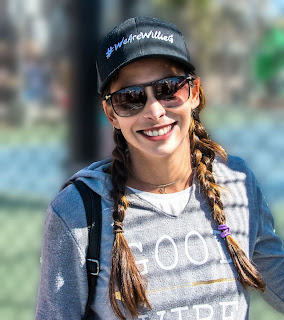The other reason for a prime lens is for its narrow depth of field so the only thing that will be in focus will be the person or people in the photo. If you want to travel light, or you don't have a lot of extra money, you might want to consider a zoom lens. Some of these have fixed focal lengths, usually around f/2.8 for the maximum aperture, or they may have variable apertures depending on what focal length is being used, and may go from f/3.5 at the maximum aperture which will be at the minimum focal length, to around f/5.6 at the maximum focal length. Besides focal length for depth of field, the distance to the subject will also affect depth of field. This photo was shot with a 28-300mm lens. There were a lot of people walking by, so had to get in close.
Keeping all of the above in mind, here is a photo I shot at Venice Beach by the paddle tennis courts. The lens was set at f/10 and 45mm (due to a limited area to shoot in).
This first photo was shot at the above settings.
In fact, the next three are the same photo used to illustrate what it would have looked like at larger and larger apertures. Because I shot only the one photo, I actually used post-processing to throw the background out of focus and simulate different f stops.
If I had something like a 50mm f/1.4 lens, it would have been much easier to get the bottom result without having to do the post-processing to blur the background. The photo below was shot with a 50mm f/1.4 lens, probably set to f/2 or f/2.8 - shot with B&W film.
And finally, the following photos were shot today. Whenever I need photos to illustrate something, if there is no one else around, I'm always available, ha ha. (Although I would have preferred to photograph the one above for the following series). All the photos of me were shot with a 28-300mm Nikon lens with almost no post processing other than to adjust the brightness. Depending on the distance from the camera as well as the f stop determines how much of the background will be in focus. The other point is the sharpness of the lens. As mentioned above, zoom lenses are not as sharp as prime lenses, but if I was the client, I would have to say these photos are more than sharp enough. The moral is: don't always believe what others say. Experiment and research from multiple sources.
40mm at f/4
Same as above, but with post-processing to illustrate the sharpness of the photo and how sharp it can be made in post-processing. This was done with a preset from ON1. This would not normally be used for a portrait for obvious reasons unless you wanted to look like you were lost in the desert for several weeks.
40mm at f/4
58mm at f/6.3
58mm at f/4.5
90mm at f/6.3
105mm@ f/5.3
122mm at f/6.3













No comments:
Post a Comment